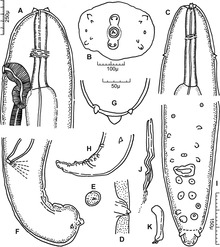Setaria (roundworm)
| Setaria | |
|---|---|
 |
|
| S. graberi, an antelope parasite | |
| Scientific classification | |
| Kingdom: | Animalia |
| Phylum: | Nematoda |
| Class: | Secernentea |
| Order: | Spirurida |
| Family: | Setariidae |
| Genus: |
Setaria Viborg, 1795 |
Setaria is a genus of parasitic roundworms that infect domesticated mammals such as pigs, camels, cattle and horses. Some species also infect wild mammals such as deer and antelope. The genus consists of about 43 species. Members of the genus are uniquely parasites in the abdominal cavity of the body. They are mostly large-sized roundworms, possessing an elaborate head (cephalic) region that is characterised by spines, presence of four lips, and well-guarded mouth. Little is known about their pathogenic effects, but some are known to affect nervous system and eye. The larval infective forms are transmitted from one animal to another by the bite of mosquitoes and flies. In addition Setaria marshalli can be transmitted from the womb to new-born calf.
A rare case of human infection was recorded in 2016 from a 15-year-old Iranian girl, who was diagnosed with Setaria equina in her eye.
Some important species of the genus are:
...
Wikipedia
